2023届高考英语二轮复习 动词的时态语态和语气课件(共24张PPT)
文档属性
| 名称 | 2023届高考英语二轮复习 动词的时态语态和语气课件(共24张PPT) |  | |
| 格式 | pptx | ||
| 文件大小 | 259.8KB | ||
| 资源类型 | 教案 | ||
| 版本资源 | 通用版 | ||
| 科目 | 英语 | ||
| 更新时间 | 2022-09-24 16:59:26 | ||
图片预览

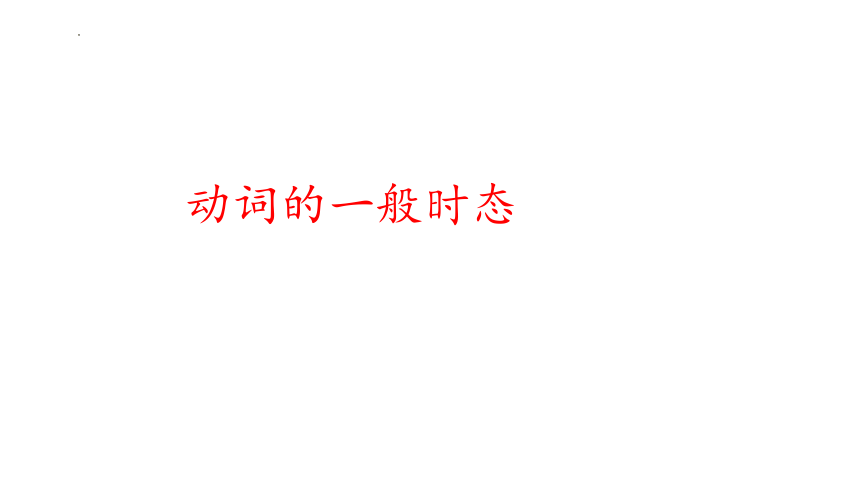
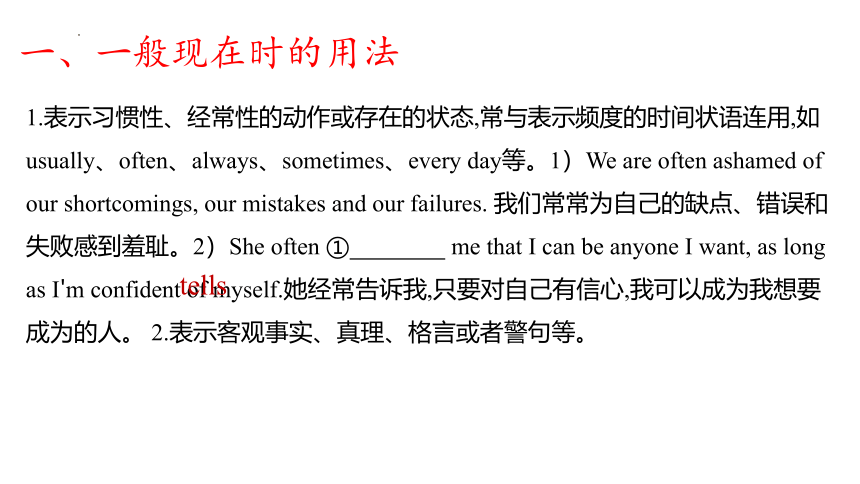
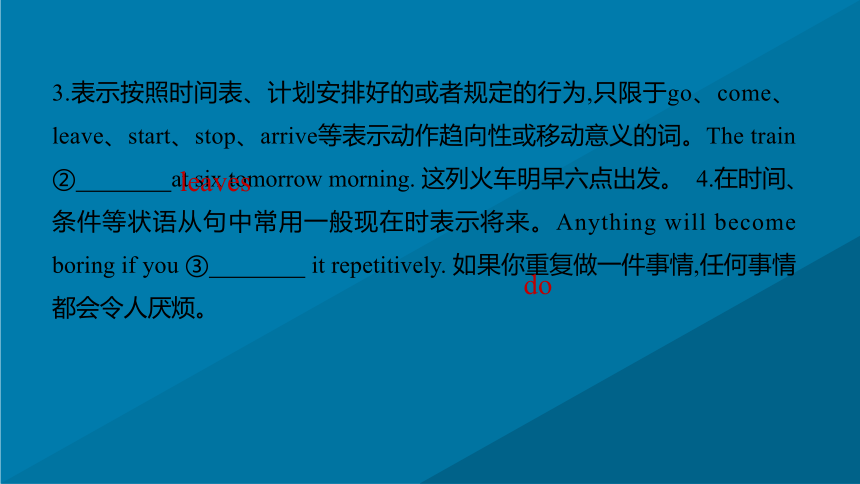

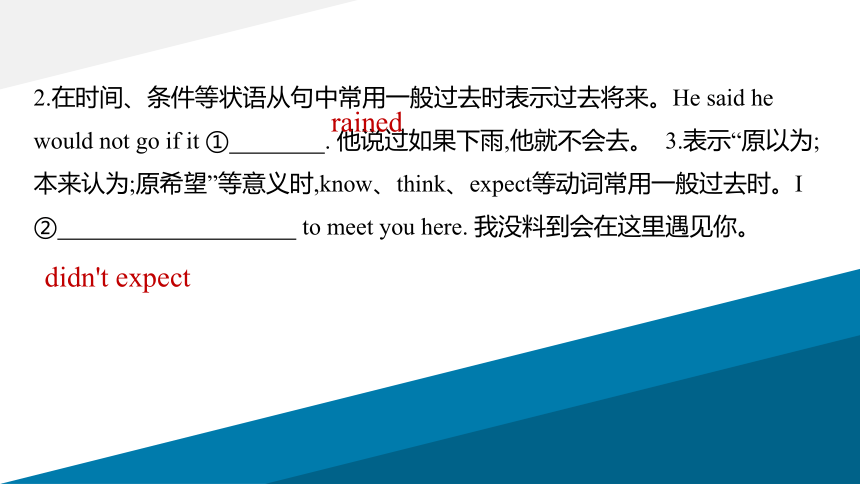
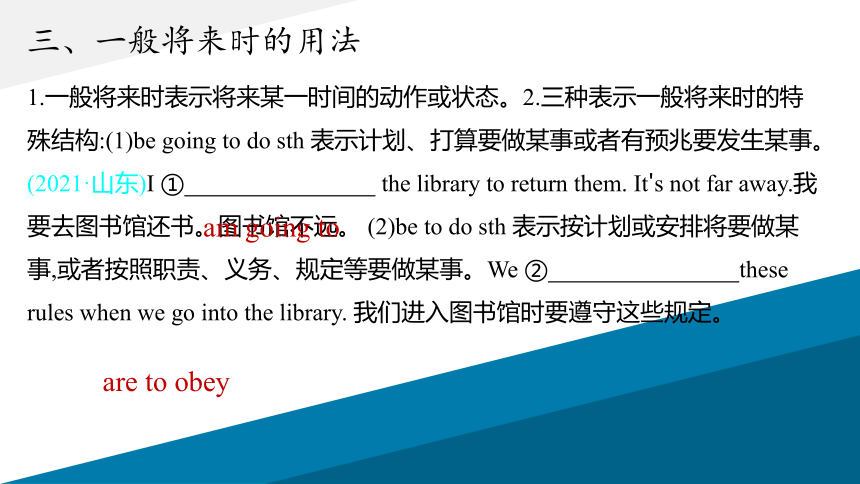
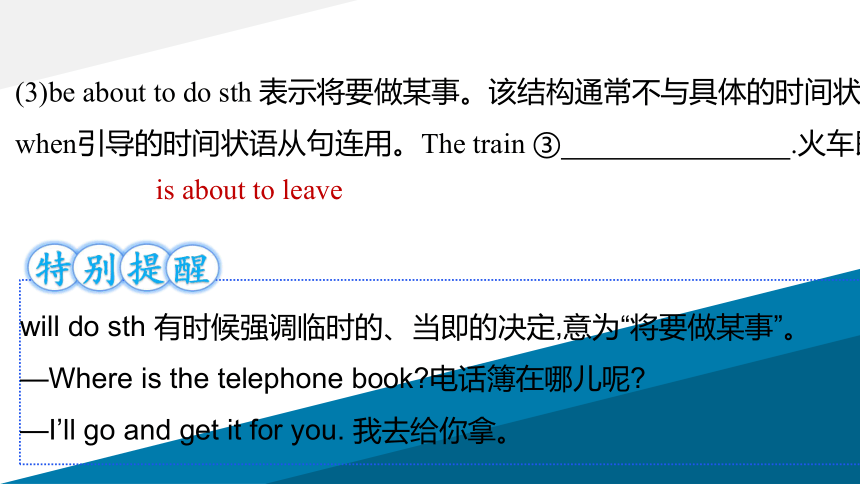
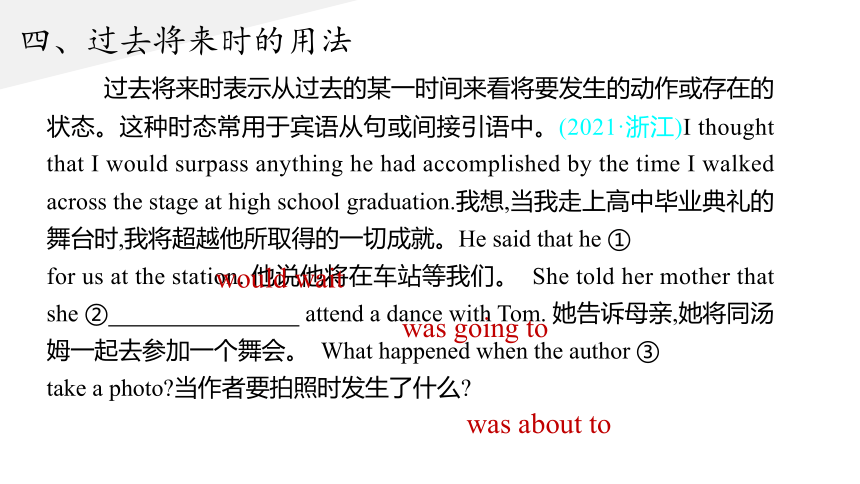
文档简介
(共24张PPT)
高中英语语法---动词的时态、语态和语气
动词的一般时态
一、一般现在时的用法
1.表示习惯性、经常性的动作或存在的状态,常与表示频度的时间状语连用,如usually、often、always、sometimes、every day等。1)We are often ashamed of our shortcomings, our mistakes and our failures. 我们常常为自己的缺点、错误和失败感到羞耻。2)She often ① me that I can be anyone I want, as long as I'm confident of myself.她经常告诉我,只要对自己有信心,我可以成为我想要成为的人。 2.表示客观事实、真理、格言或者警句等。
tells
3.表示按照时间表、计划安排好的或者规定的行为,只限于go、come、leave、start、stop、arrive等表示动作趋向性或移动意义的词。The train ② at six tomorrow morning. 这列火车明早六点出发。 4.在时间、条件等状语从句中常用一般现在时表示将来。Anything will become boring if you ③ it repetitively. 如果你重复做一件事情,任何事情都会令人厌烦。
leaves
do
二、一般过去时
1.表示过去某一时间发生的动作或存在的状态,常用yesterday、last year、the other day 等作时间状语。1)Excuse me. I'm sorry that these books were due yesterday.对不起,我很抱歉这些书昨天到期了。2)The unmanned Chang'e-4 probe—the name was inspired by an ancient Chinese moon goddess—touched down last week in the South Pole-Aitken basin.无人月球探测器嫦娥四号——名字的灵感来自古代中国的月亮女神——上周在南极艾特肯盆地着陆。
Key
words
2.在时间、条件等状语从句中常用一般过去时表示过去将来。He said he would not go if it ① . 他说过如果下雨,他就不会去。 3.表示“原以为;本来认为;原希望”等意义时,know、think、expect等动词常用一般过去时。I ② to meet you here. 我没料到会在这里遇见你。
rained
didn't expect
Key
words
三、一般将来时的用法
1.一般将来时表示将来某一时间的动作或状态。2.三种表示一般将来时的特殊结构:(1)be going to do sth 表示计划、打算要做某事或者有预兆要发生某事。(2021·山东)I ① the library to return them. It's not far away.我要去图书馆还书。图书馆不远。 (2)be to do sth 表示按计划或安排将要做某事,或者按照职责、义务、规定等要做某事。We ② these rules when we go into the library. 我们进入图书馆时要遵守这些规定。
am going to
are to obey
Key
words
(3)be about to do sth 表示将要做某事。该结构通常不与具体的时间状语连用,但常与when引导的时间状语从句连用。The train ③ .火车即将开出。
is about to leave
will do sth 有时候强调临时的、当即的决定,意为“将要做某事”。
—Where is the telephone book 电话簿在哪儿呢
—I’ll go and get it for you. 我去给你拿。
特
别
提
醒
Key
words
四、过去将来时的用法
过去将来时表示从过去的某一时间来看将要发生的动作或存在的状态。这种时态常用于宾语从句或间接引语中。(2021·浙江)I thought that I would surpass anything he had accomplished by the time I walked across the stage at high school graduation.我想,当我走上高中毕业典礼的舞台时,我将超越他所取得的一切成就。He said that he ① for us at the station. 他说他将在车站等我们。 She told her mother that she ② attend a dance with Tom. 她告诉母亲,她将同汤姆一起去参加一个舞会。 What happened when the author ③ take a photo 当作者要拍照时发生了什么
would wait
was going to
was about to
Key
words
如果表示从过去某时看将要发生的动作或存在的状态,要用过去将来时。该时态主要出现在间接引语中。
I telephoned him yesterday to ask what I would/should do the next week.我昨天给他打电话,问他我下周要干什么。
特
别
提
二、动词的进行时态
一、现在进行时的用法
1.表示此时此刻正在进行的动作,由“am/is/are+现在分词”构成。Her mother, Solio, is a first-time mum and she is doing a fantastic job.她的母亲,索里奥,是第一次当妈妈,并且她干得很出色。What are you doing 你正在干什么 2.表示按计划、安排近期要发生的动作。I ① for Beijing tomorrow. 明天我要到北京去。 3.与always、forever、constantly等副词连用,表示满意、称赞、厌恶等感彩。He ② others. 他总是帮助别人。
am leaving
is always helping
4.表示逐渐变化的过程。
His health ③ every day. 他的健康状况每天都在好转。
下列动词(短语)不宜用进行时:
●感觉类:look、smell、feel、sound、taste、see、hear等。
●感情类:like、love、prefer、admire、hate、fear等。
●所有类:have、contain、own、hold、belong to等。
特
别
提
醒
is improving
二、过去进行时的用法
1.表示过去某一时间、某一阶段正在进行的动作,由“was/were+现在分词”构成。(2021·新高考Ⅱ)The twins were filled with excitement as they thought of the surprise they ① for Mother's Day.这对双胞胎一想到他们正在为母亲节准备的惊喜就兴奋不已。 2.与always、forever、constantly等副词连用,表示满意、称赞、厌恶等感彩。He ② others,never thinking of himself. 他总是考虑别人,从未考虑过自己。
were planning
was/is always thinking of
三、将来进行时的用法
将来进行时表示将来某一时间、某一阶段正在进行的动作,由“will / shall be +现在分词”构成。Jane can't attend the meeting at 3 o'clock this afternoon because she ____________ a class at that time.简不能出席今天下午3点的会议,因为在那个时候她正在上课。
will be teaching
三、动词的完成时态
一、现在完成时
1.表示过去发生或已经完成的某一动作对现在造成的影响或结果,常用的时间状语有already、so far、never、just、before、recently等。1)Who is a genius This question ① humankind for centuries.谁是天才 几个世纪以来,这个问题一直引起人类极大的兴趣。 2)His efforts have resulted in 1,360 acres of naturally-grown land that has become home to many plants and animals.他的努力使1 360英亩自然生长的土地成为许多动植物的家园。
has greatly interested
2.表示过去发生并持续到现在的动作或状态,甚至延续到将来,常与since、for、so far、now、today、this week / month / year、for a long time、in the past/last few years、these days等连用。We ② 500 words these days. 我们这些天已经学习了500个单词。 3.用在时间和条件状语从句中,表示将来某一时间完成的动作。If you ③ the wrong name in an email, it is best to apologise in a serious manner. 你如果在电子邮件中写错了名字,最好以严肃的方式道歉。
have learnt
have written
注意牢记以下固定句型:●“It is/has been+时间段+since...”表示“自从……以来已经……”。It is/has been ten years since I graduated from the university. 我从这所大学毕业已经十年了。●This/It/That is the first/second/third...time(that)... 表示“这/那是(某人)第几次做某事”,that从句要用现在完成时。This is the first time that I have been here. 这是我第一次来这里。
二、过去完成时
1.表示在过去某一动作之前已经完成的动作,强调“过去的过去”之意。常与by、before等介词或状语从句连用或用于有上下文暗示的句子。1)My grandfather was afraid of leaving the only home they ① for the past 60 years.我的祖父害怕离开他们60年来唯一熟知的家。 2.表示意向的动词,如hope、wish、expect、think、intend、mean、suppose等,用过去完成时表示“原本……(事实上未能……)”。We ② that you would be able to win the match. 我们本来期待的是你能赢得这场比赛。
had known
had known
had known
had known
had known
had expected
●固定句型“This/It/That was the first/second/third time(that)... ”表示“这/那是(某人)第几次做某事”,that从句要用过去完成时。This was the first time that they had ever met. 这是他们初次见面。●在“hardly... when... ”和“no sooner... than...” 这两个句型中,主句均用过去完成时。Hardly had we arrived when the match started. 我们一到场,比赛就开始了。
1.We (hire) our bikes from the rental place at the South Gate. My bike was old and shaky but did the job. 2.You can't help wondering how hard it (be) for the people then to put all those rocks into place. 3.It is calculated by dividing a person's weight in kg by their height in meters squared, and a BMI of between 19 and 25 (consider) healthy. 4.It doesn't impress like George Washington's plantation on the Potomac, but Lincoln's home in downtown Springfield, Illinois, (prove) irresistible to visitors since it opened to the public. 5.The little home (paint) white. It was sweet and fresh.
was
is considered
has proved/has proven
was painted
was painted
was painted
hired
热点全面检测
单句填空
1.(2021·全国甲)We (hire) our bikes from the rental place at the South Gate. My bike was old and shaky but did the job. 2.(2021·新高考Ⅰ)You can't help wondering how hard it (be) for the people then to put all those rocks into place. 3.(2021·浙江1月)It is calculated by dividing a person's weight in kg by their height in meters squared, and a BMI of between 19 and 25 (consider) healthy. 4.(2021·浙江)It doesn't impress like George Washington's plantation on the Potomac, but Lincoln's home in downtown Springfield, Illinois, (prove) irresistible to visitors since it opened to the public. 5.(2021·浙江)The little home (paint) white. It was sweet and fresh.
hired
was
is considered
has proved/has proven
was painted
1.hired 分析句子可知,此处应用谓语动词。根据上下文可知,此处描述过去发生的事情,应用一般过去时。
2.was 分析句子可知,it是形式主语,后面的不定式为真正主语,谓语动词用单数形式;根据时间状语then可知,此处应用一般过去时。
3.is considered 分析句子可知,此处应用谓语动词。主语a BMI是单数,且主语和动词consider之间是动宾关系,本句时态是一般现在时,故用一般现在时的被动语态。
4.has proved/has proven 分析句子可知,此处应用谓语动词。根据空后的时间状语从句since it opened to the public可知,此处用现在完成时。主语Lincoln's home 是第三人称单数,故填has proved或has proven。
5.was painted 主语The little home与谓语动词paint之间是动宾关系,故用被动语态;根据下文的时态可知,此处用一般过去时。
THANK YOU
高中英语语法---动词的时态、语态和语气
动词的一般时态
一、一般现在时的用法
1.表示习惯性、经常性的动作或存在的状态,常与表示频度的时间状语连用,如usually、often、always、sometimes、every day等。1)We are often ashamed of our shortcomings, our mistakes and our failures. 我们常常为自己的缺点、错误和失败感到羞耻。2)She often ① me that I can be anyone I want, as long as I'm confident of myself.她经常告诉我,只要对自己有信心,我可以成为我想要成为的人。 2.表示客观事实、真理、格言或者警句等。
tells
3.表示按照时间表、计划安排好的或者规定的行为,只限于go、come、leave、start、stop、arrive等表示动作趋向性或移动意义的词。The train ② at six tomorrow morning. 这列火车明早六点出发。 4.在时间、条件等状语从句中常用一般现在时表示将来。Anything will become boring if you ③ it repetitively. 如果你重复做一件事情,任何事情都会令人厌烦。
leaves
do
二、一般过去时
1.表示过去某一时间发生的动作或存在的状态,常用yesterday、last year、the other day 等作时间状语。1)Excuse me. I'm sorry that these books were due yesterday.对不起,我很抱歉这些书昨天到期了。2)The unmanned Chang'e-4 probe—the name was inspired by an ancient Chinese moon goddess—touched down last week in the South Pole-Aitken basin.无人月球探测器嫦娥四号——名字的灵感来自古代中国的月亮女神——上周在南极艾特肯盆地着陆。
Key
words
2.在时间、条件等状语从句中常用一般过去时表示过去将来。He said he would not go if it ① . 他说过如果下雨,他就不会去。 3.表示“原以为;本来认为;原希望”等意义时,know、think、expect等动词常用一般过去时。I ② to meet you here. 我没料到会在这里遇见你。
rained
didn't expect
Key
words
三、一般将来时的用法
1.一般将来时表示将来某一时间的动作或状态。2.三种表示一般将来时的特殊结构:(1)be going to do sth 表示计划、打算要做某事或者有预兆要发生某事。(2021·山东)I ① the library to return them. It's not far away.我要去图书馆还书。图书馆不远。 (2)be to do sth 表示按计划或安排将要做某事,或者按照职责、义务、规定等要做某事。We ② these rules when we go into the library. 我们进入图书馆时要遵守这些规定。
am going to
are to obey
Key
words
(3)be about to do sth 表示将要做某事。该结构通常不与具体的时间状语连用,但常与when引导的时间状语从句连用。The train ③ .火车即将开出。
is about to leave
will do sth 有时候强调临时的、当即的决定,意为“将要做某事”。
—Where is the telephone book 电话簿在哪儿呢
—I’ll go and get it for you. 我去给你拿。
特
别
提
醒
Key
words
四、过去将来时的用法
过去将来时表示从过去的某一时间来看将要发生的动作或存在的状态。这种时态常用于宾语从句或间接引语中。(2021·浙江)I thought that I would surpass anything he had accomplished by the time I walked across the stage at high school graduation.我想,当我走上高中毕业典礼的舞台时,我将超越他所取得的一切成就。He said that he ① for us at the station. 他说他将在车站等我们。 She told her mother that she ② attend a dance with Tom. 她告诉母亲,她将同汤姆一起去参加一个舞会。 What happened when the author ③ take a photo 当作者要拍照时发生了什么
would wait
was going to
was about to
Key
words
如果表示从过去某时看将要发生的动作或存在的状态,要用过去将来时。该时态主要出现在间接引语中。
I telephoned him yesterday to ask what I would/should do the next week.我昨天给他打电话,问他我下周要干什么。
特
别
提
二、动词的进行时态
一、现在进行时的用法
1.表示此时此刻正在进行的动作,由“am/is/are+现在分词”构成。Her mother, Solio, is a first-time mum and she is doing a fantastic job.她的母亲,索里奥,是第一次当妈妈,并且她干得很出色。What are you doing 你正在干什么 2.表示按计划、安排近期要发生的动作。I ① for Beijing tomorrow. 明天我要到北京去。 3.与always、forever、constantly等副词连用,表示满意、称赞、厌恶等感彩。He ② others. 他总是帮助别人。
am leaving
is always helping
4.表示逐渐变化的过程。
His health ③ every day. 他的健康状况每天都在好转。
下列动词(短语)不宜用进行时:
●感觉类:look、smell、feel、sound、taste、see、hear等。
●感情类:like、love、prefer、admire、hate、fear等。
●所有类:have、contain、own、hold、belong to等。
特
别
提
醒
is improving
二、过去进行时的用法
1.表示过去某一时间、某一阶段正在进行的动作,由“was/were+现在分词”构成。(2021·新高考Ⅱ)The twins were filled with excitement as they thought of the surprise they ① for Mother's Day.这对双胞胎一想到他们正在为母亲节准备的惊喜就兴奋不已。 2.与always、forever、constantly等副词连用,表示满意、称赞、厌恶等感彩。He ② others,never thinking of himself. 他总是考虑别人,从未考虑过自己。
were planning
was/is always thinking of
三、将来进行时的用法
将来进行时表示将来某一时间、某一阶段正在进行的动作,由“will / shall be +现在分词”构成。Jane can't attend the meeting at 3 o'clock this afternoon because she ____________ a class at that time.简不能出席今天下午3点的会议,因为在那个时候她正在上课。
will be teaching
三、动词的完成时态
一、现在完成时
1.表示过去发生或已经完成的某一动作对现在造成的影响或结果,常用的时间状语有already、so far、never、just、before、recently等。1)Who is a genius This question ① humankind for centuries.谁是天才 几个世纪以来,这个问题一直引起人类极大的兴趣。 2)His efforts have resulted in 1,360 acres of naturally-grown land that has become home to many plants and animals.他的努力使1 360英亩自然生长的土地成为许多动植物的家园。
has greatly interested
2.表示过去发生并持续到现在的动作或状态,甚至延续到将来,常与since、for、so far、now、today、this week / month / year、for a long time、in the past/last few years、these days等连用。We ② 500 words these days. 我们这些天已经学习了500个单词。 3.用在时间和条件状语从句中,表示将来某一时间完成的动作。If you ③ the wrong name in an email, it is best to apologise in a serious manner. 你如果在电子邮件中写错了名字,最好以严肃的方式道歉。
have learnt
have written
注意牢记以下固定句型:●“It is/has been+时间段+since...”表示“自从……以来已经……”。It is/has been ten years since I graduated from the university. 我从这所大学毕业已经十年了。●This/It/That is the first/second/third...time(that)... 表示“这/那是(某人)第几次做某事”,that从句要用现在完成时。This is the first time that I have been here. 这是我第一次来这里。
二、过去完成时
1.表示在过去某一动作之前已经完成的动作,强调“过去的过去”之意。常与by、before等介词或状语从句连用或用于有上下文暗示的句子。1)My grandfather was afraid of leaving the only home they ① for the past 60 years.我的祖父害怕离开他们60年来唯一熟知的家。 2.表示意向的动词,如hope、wish、expect、think、intend、mean、suppose等,用过去完成时表示“原本……(事实上未能……)”。We ② that you would be able to win the match. 我们本来期待的是你能赢得这场比赛。
had known
had known
had known
had known
had known
had expected
●固定句型“This/It/That was the first/second/third time(that)... ”表示“这/那是(某人)第几次做某事”,that从句要用过去完成时。This was the first time that they had ever met. 这是他们初次见面。●在“hardly... when... ”和“no sooner... than...” 这两个句型中,主句均用过去完成时。Hardly had we arrived when the match started. 我们一到场,比赛就开始了。
1.We (hire) our bikes from the rental place at the South Gate. My bike was old and shaky but did the job. 2.You can't help wondering how hard it (be) for the people then to put all those rocks into place. 3.It is calculated by dividing a person's weight in kg by their height in meters squared, and a BMI of between 19 and 25 (consider) healthy. 4.It doesn't impress like George Washington's plantation on the Potomac, but Lincoln's home in downtown Springfield, Illinois, (prove) irresistible to visitors since it opened to the public. 5.The little home (paint) white. It was sweet and fresh.
was
is considered
has proved/has proven
was painted
was painted
was painted
hired
热点全面检测
单句填空
1.(2021·全国甲)We (hire) our bikes from the rental place at the South Gate. My bike was old and shaky but did the job. 2.(2021·新高考Ⅰ)You can't help wondering how hard it (be) for the people then to put all those rocks into place. 3.(2021·浙江1月)It is calculated by dividing a person's weight in kg by their height in meters squared, and a BMI of between 19 and 25 (consider) healthy. 4.(2021·浙江)It doesn't impress like George Washington's plantation on the Potomac, but Lincoln's home in downtown Springfield, Illinois, (prove) irresistible to visitors since it opened to the public. 5.(2021·浙江)The little home (paint) white. It was sweet and fresh.
hired
was
is considered
has proved/has proven
was painted
1.hired 分析句子可知,此处应用谓语动词。根据上下文可知,此处描述过去发生的事情,应用一般过去时。
2.was 分析句子可知,it是形式主语,后面的不定式为真正主语,谓语动词用单数形式;根据时间状语then可知,此处应用一般过去时。
3.is considered 分析句子可知,此处应用谓语动词。主语a BMI是单数,且主语和动词consider之间是动宾关系,本句时态是一般现在时,故用一般现在时的被动语态。
4.has proved/has proven 分析句子可知,此处应用谓语动词。根据空后的时间状语从句since it opened to the public可知,此处用现在完成时。主语Lincoln's home 是第三人称单数,故填has proved或has proven。
5.was painted 主语The little home与谓语动词paint之间是动宾关系,故用被动语态;根据下文的时态可知,此处用一般过去时。
THANK YOU
